| Choices for Sustainable Living |
 | Our food choices are part of sustainability
|
|
We'll be hosting Choices for Sustainable Living, a Northwest Earth Institute discussion series at our home in Westvale on seven Friday evenings from Sept. 13 to Oct. 25. NOTE: If you'd like to participate, but Friday evenings aren't good for you, would Saturday or Sunday be better? Would a different venue be preferable?Participants read each week's material on their own before each meeting, and then we discuss the ideas at the meeting. Materials include brief articles or book excerpts from well-known authors such as Michael Pollan or Barbara Kingsolver, and preparation generally takes about an hour. See the course flyer and more about the program at https://www.nwei.org/discussion-courses/choices-for-sustainable-living/ and more about the Northwest Earth Institute at www.nwei.org. Materials for the first eight participants are available on loan from the library and will be distributed at the first meeting. |
| Summer Camp at Baltimore Woods | 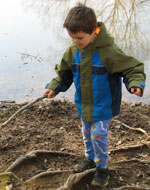 |
A Baltimore Woods summer tradition for over 25 years! Our week-long day camp adventures promote discovery, physical fitness, problem-solving skills, social interaction, and awareness through direct contact with the natural world. Running weekly from
July 8 - August 30, themed camps include: Nature's Little Explorers (ages 4 and 5) Nature & Art Camp(4th - 6th grade) Voyager Camp(5th-8th grade) Teen Camp(9th-11th grade) Sportman's Education Camp (ages 12-17) Register by calling 673-1350 or visit the website at www.baltimorewoods.org for more details. |
| Our Habitat Garden | 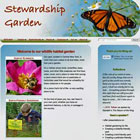 |
Visit Our Habitat Garden website for information on providing habitat, earth-friendly gardening practices, plants, and various creatures here in Central New York.
|
HGCNY Officers
| |
| President:
Janet Allen
Vice-President:
Carol Biesemeyer
Treasurer:
Randi Starmer
Secretary:
Soule Leiter
Membership:
Linda Rossiter
Program Chair:
Carol Biesemeyer
Newsletter Editor:
Janet Allen
Additional Planning Committee Members:
Beth Mitchell
Dave Mitchell
John Allen
Peter Huntington
|
| HGCNY on Facebook |
As as more of us participate on our Facebook page, this will become a useful resource for asking (and answering!) local HGCNYers' questions about habitat gardening. |
|
Join HGCNY!
|  |
Becoming an official member of HGCNY is easy: just join Wild Ones! Basic household membership is $37/year, but there are other options, too. (See membership application or website.)
Wild Ones
P.O. Box 1274
Appleton, Wisconsin 54912-1274
Make checks payable to Wild Ones.
Or telephone toll-free 877-394-9453.
|
|
Our Edible Garden
|  | Visit OurEdibleGarden.org to see an example of a Central New York edible garden, the perfect companion to your habitat garden.
|
| Interested in Edible Gardening? | 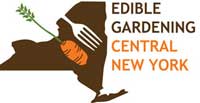
|
If you'd like to get information on Edible Gardening CNY, just email John to find out about edible gardening tours and monthly programs. Free and open to the public! |
|
Annual Picnic and Hike Sat. Aug. 24
We'll hold our annual potluck picnic and hike at Randi Starmer's property, in the town of Pompey, just south of Jamesville.
9:30 am: There will be a hike to explore her property. If you sign up but are unable to make it, please email Randi by Friday 8/23 or phone her by 9:30 am on Saturday so we don't wait for you.
12 noon: Whether you join the hike or not, everyone is welcome to come for just the pot luck picnic. Paper plates, cups, napkins and forks will be provided, and attendees please bring a potluck dish to share!
Directions to the Randi's: Please email Randi and she'll send a .pdf with the directions to her house and phone number.
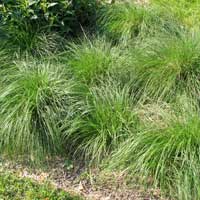 | | Prairie dropseed |
Native Plant Sale Saturday Sept. 7The annual HGCNY plant sale will be held on Saturday Sept. 7 from 9:30 am to noon. Plants not sold on Saturday will be available on Sunday Sept. 8 from 1 pm to 3 pm. Location: At the Allens ( directions). We will have plants from The Plantsmen, Amanda's Garden, and Maple Hill Landscaping along with plants donated by HGCNYers. Most plants will be in the range of $4 to $10. If there are particular plants that you want please let us know and we'll try to acquire them and, if numbers are limited, hold them for you. Send your requests to John at ediblecny@gmail.com. Shrub and tree seedlings Tree and shrub seedlings will also be available by ordering in advance. These pre-orders will be available at the sale on Saturday. To see what shrubs and trees are available go to www.whiteoaknursery.biz and click on "Potted Seedlings". To cover the additional costs of the container and delivery and as a small contribution toward the cost of our monthly programs, our price will be $5 more than the price listed on the White Oak Nursery website. To order the seedlings email John listing the name of the tree or shrub, the number you want, and the price, i.e. the White Oak Nursery price + $5. If you're not able to pick them up on Sat., Sept. 7 between 9:30 am and noon, indicate that you need to arrange another time/date. Plant donationsIf you have plants to donate, you can bring them between 8 am and 9 am the day of the sale or by arranging a time a day or two earlier. People who bring plants between 8 am and 9 am on the day of the sale will have the opportunity to buy plants prior to the 9:30 am starting time. Contact John if you want to bring plants before September 7. Thank you for participating in our plant sale! It not only gets native plants planted in CNY for the benefit of people and wildlife, but also funds this newsletter, our programs, and other projects! Janet Allen
President, HGCNY |
|
|
Weed-suppressing groundcovers
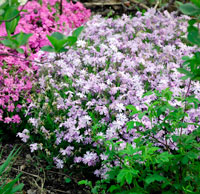 | | Moss phlox |
Groundcovers are appealing because they "cover the ground," but don't need to be mowed as does our most common groundcover: turf grass. People often think of groundcovers as something that mimics turf grass -- uniform, green, and low to the ground.
But many native plants can provide a uniform appearance, suppress weeds, and require little or no maintenance while also providing much-needed habitat for birds, butterflies, and bees. Because they don't mimic turfgrass, they're much more interesting and appealing. And does the world truly need to have more turfgrass (or even look like it has)?
These are all ornamental plants that many of us already grow as part of our gardens and landscapes. So what makes these plants groundcovers rather than just a plant in our landscape? They're planted en masse in a defined area so they have a uniform appearance.
Some natives recommended by Cornell Cooperative Extension that work as weed-suppressive groundcovers are:
Moss phlox (Phlox subulata): 4-6 inches high, mat forming. Early spring flowers, glossy evergreen foliage. Full sun. Tolerates drought and even a little salt. Grows best in well-drained soil.
Butterfly weed (Asclepias tuberosa): 12-24 inches high, sprawling. Bright orange flowers in summer, dark green foliage. Full sun. Drought tolerant. Prefers poor soil. Little bluestem (Schizachyrium scoparium): 20-40 inches high, clump forming. Tall, slender blue-green leaves turn to golden bronze in fall. Free to bend and sway, provides a prairie look. Full sun. Remove previous year's foliage by cutting to the ground in late winter/early spring. Northern dropseed (Sporobolus heterolepsis): 24-48 inches high (including its "flower" stalks), clump forming. Graceful, fine-textured grass. In late summer tall lightly fragrant flowers/seed heads are produced. Foliage fades golden to bronze in fall/winter. Full sun. Drought tolerant. Grows best in well-drained soils. Right plant in the right conditions As with any plant, choose the plants that fit your light exposure and soil conditions, as well as any other special conditions (such as road salt etc.). And as with any other landscape plant, even though they are low maintenance when established, they need some special care at the start. Another difference, of course, between using these as landscape plants as opposed to groundcover is that you'll need to buy a number of them rather than a few. The rewards for choosing these as opposed to the usual non-native pachysandra or the invasive vinca/myrtle are that you'll not only have a more interesting landscape -- not the cooky-cutter landscapes so prevalent today -- but also one that enhances biodiversity, providing habitat for many creatures. |
|
Do you use neonicotinoids?
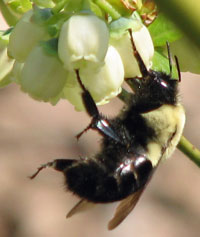 | | Bumblebee pollinating blueberries |
You may have seen the term "neonicotinoids" appearing frequently in recent news articles concerning bee deaths.
Neonicotinoids are a class of pesticides that have recently been banned in the European Union because of their suspected contribution to bee deaths.
The Xerces Society, an invertebrate conservation organization, has on their website the article "Are neonicotinoids killing bees?" at http://www.xerces.org/neonicotinoids-and-bees/. A complete report is available on that page, but some key highlights Xerces lists are:
- Several of these insecticides are highly toxic to honey bees and bumblebees.
- Neonicotinoid residues are found in pollen and nectar consumed by pollinators such as bees and butterflies. The residues can reach lethal concentrations in some situations.
- Neonicotinoids can persist in soil for months or years after a single application. Measurable amounts of residues were found in woody plants up to six years after application.
- Untreated plants may absorb chemical residues left over in the soil from the previous year.
- Products approved for homeowners to use in gardens, lawns, and on ornamental trees have manufacturer-recommended application rates up to 120 times higher than rates approved for agricultural crops.
- Many neonicotinoid pesticides that are sold to homeowners for use on lawns and gardens do not have any mention of the risks of these products to bees, and the label guidance for products used in agriculture is not always clear or consistent.
You may be using neonics and not know it!
They aren't called "neonicotinoids" in the store. Examples of some common brands are Marathon, Merit, Ortho Rose and Flower Insect Killer, and many others. See a more complete list of brands of neonicotinoid pesticides on the Xerces Society page listed above.
In addition to bees and butterflies, in March 2013 the American Bird Conservancy published a review of 200 studies on neonicotinoids calling for a ban on neonicotinoid use as seed treatments because of their toxicity to birds, aquatic invertebrates, and other wildlife.
|
|
Monarch miscellany
If you're able to make a trip to the Adirondack's Wild Center at Tupper Lake on August 23 and 24, you have an opportunity to hear Dr. Chip Taylor, director of Monarch Watch, address the current plight of monarchs (Sat.) and see The Flight of the Butterflies movie following by monarch tagging with Dr. Taylor. (And the Wild Center itself is a very worthy destination.) To make reservations and for more information, contact the Wild Center at https://www.wildcenter.org/. BUT if you're not able to make the trip, it will be live-cast at http://www.wildcenter.org/live/. Up close and personal On the Science Friday website, you can see an image of a monarch egg taken by a scanning electron microscope. And on the Journey North website, you can see many fascinating scanning electron microscope images of the monarch's cremaster (the black "stem" that attaches the caterpillar to the silk pad before it pupates). In fact, to find the answers to almost any question you might have about monarchs, visit the Journey North website's fact pages. |
|
|
Native Plant Shopping Guide
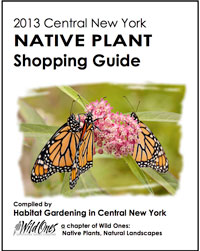 | | Click image to download the Guide |
Are you looking for native plants in general or a particular native plant?
Chances are, you can find them somewhere in CNY.
Our 2013 Native Plant Shopping Guide shows you where. You're welcome to download it by clicking on the image to the right, OR you can download it from our website homepage (midway down the page). It's free!
As always, we recommend that you call ahead if you're looking for a particular plant. Some less common native plants may be in short supply, and you wouldn't want to waste a trip to find that your plant had sold out. |
|
|